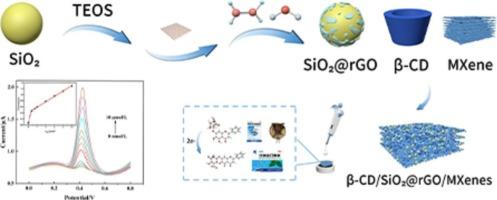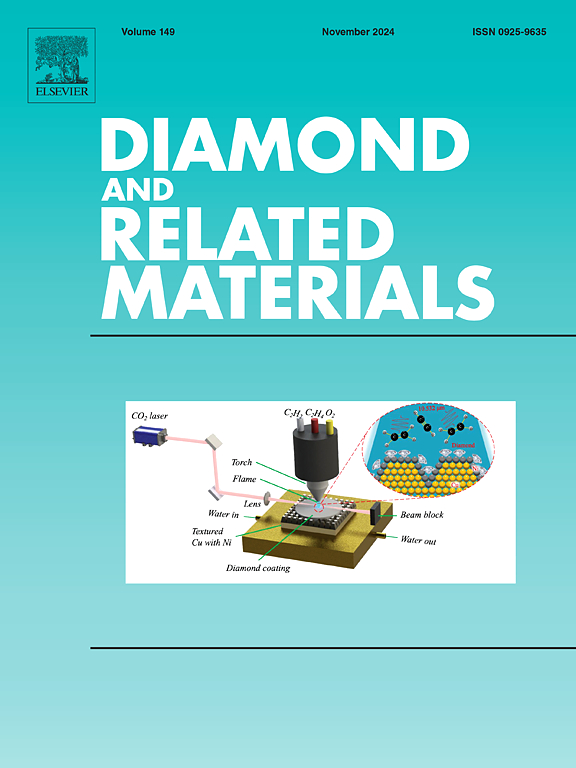制备具有三维结构的β-CD/SiO2@rGO/MXenes 复合材料,用于中药中黄芩苷的灵敏检测
IF 5.1
3区 材料科学
Q2 MATERIALS SCIENCE, COATINGS & FILMS
引用次数: 0
摘要
黄芩苷是传统中药的主要成分,在治疗关节炎、呼吸道感染、慢性和急性肝炎以及肿瘤等疾病方面发挥着重要作用。氧化石墨烯通过共价键或氢键与二氧化硅(SiO2)结合,再通过水合肼还原成 SiO2@rGO,解决了 SiO2 容易堆积的问题,提高了材料的导电性。接着,β-环糊精(β-CD)自组装在 SiO2@rGO 上,形成稳定的包合物。β-CD 的疏水内腔可有效容纳各种客体分子形成包合物,从而增强分子识别和检测能力。最后,β-CD/SiO2@rGO 通过静电作用桥接并表面负载于粘土状 Ti3C2Tx(MXenes)纳米片之间,形成稳定的三维复合材料。正是由于 MXenes 具有独特的层状微结构、优异的导电性和广泛的亲水表面积,因此有利于在水溶液中自组装或嵌入纳米粒子。该复合材料通过 X 射线衍射、X 射线光电子能谱和扫描电子显微镜进行了表征。在优化条件下,该复合材料构建的电化学传感器对黄芩苷的检测范围宽(0.008-10 μM),检测限低(0.191 nM)。与现有的黄芩苷检测方法相比,该方法具有很强的抗干扰能力和稳定性。该方法能高效、灵敏、准确地定量检测黄芩根、双黄连口服液、熊胆黄芩滴眼液等中成药样品中的黄芩苷,回收率令人满意。本研究介绍了一种电化学检测黄芩苷的新方法。本文章由计算机程序翻译,如有差异,请以英文原文为准。

Fabrication of β-CD/SiO2@rGO/MXenes composite materials with three-dimensional structures for sensitive detection of baicalin in Chinese medicine
Baicalin is a principal component of traditional Chinese medicine and plays a crucial role in treating conditions such as arthritis, respiratory tract infections, chronic and acute hepatitis, and tumors. Graphene oxide is bonded to silicon dioxide (SiO2) through covalent bonds or hydrogen bonds and then reduced to SiO2@rGO through hydrazine hydrate to solve the problem of easy accumulation of SiO2 and improve the conductivity of the material. Next, β-cyclodextrin (β-CD) self-assembles on SiO2@rGO to form a stable inclusion complex. The hydrophobic inner cavity of β-CD can effectively accommodate various guest molecules to form inclusion complexes, enhancing molecular recognition and detection capabilities. Finally, β-CD/SiO2@rGO is bridged and surface-loaded between clay-like Ti3C2Tx (MXenes) nanosheets through electrostatic interactions to form a stable three-dimensional composite material. It is precisely because of MXenes, due to their unique layered microstructure, excellent conductivity, and extensive hydrophilic surface area, that they are conducive to self-assembly or embedding nanoparticles in aqueous solution. The composite was characterized via X-ray diffraction, X-ray photoelectron spectroscopy, and scanning electron microscopy. Under optimized conditions, the electrochemical sensor constructed from this composite exhibited a broad detection range (0.008–10 μM) and a low detection limit (0.191 nM) for baicalin. In comparison to existing methods for detecting baicalin, this approach demonstrates strong anti-interference capabilities and stability. It can efficiently, sensitively, and accurately quantify baicalin in Chinese patent medicine samples, including Scutellaria baicalensis root, Shuanghuanglian oral liquid, and Bear Bile Scutellaria baicalensis eye drops, achieving a satisfactory recovery rate. This study introduces a novel approach for the electrochemical detection of baicalin.
求助全文
通过发布文献求助,成功后即可免费获取论文全文。
去求助
来源期刊

Diamond and Related Materials
工程技术-材料科学:综合
CiteScore
6.00
自引率
14.60%
发文量
702
审稿时长
2.1 months
期刊介绍:
DRM is a leading international journal that publishes new fundamental and applied research on all forms of diamond, the integration of diamond with other advanced materials and development of technologies exploiting diamond. The synthesis, characterization and processing of single crystal diamond, polycrystalline films, nanodiamond powders and heterostructures with other advanced materials are encouraged topics for technical and review articles. In addition to diamond, the journal publishes manuscripts on the synthesis, characterization and application of other related materials including diamond-like carbons, carbon nanotubes, graphene, and boron and carbon nitrides. Articles are sought on the chemical functionalization of diamond and related materials as well as their use in electrochemistry, energy storage and conversion, chemical and biological sensing, imaging, thermal management, photonic and quantum applications, electron emission and electronic devices.
The International Conference on Diamond and Carbon Materials has evolved into the largest and most well attended forum in the field of diamond, providing a forum to showcase the latest results in the science and technology of diamond and other carbon materials such as carbon nanotubes, graphene, and diamond-like carbon. Run annually in association with Diamond and Related Materials the conference provides junior and established researchers the opportunity to exchange the latest results ranging from fundamental physical and chemical concepts to applied research focusing on the next generation carbon-based devices.
 求助内容:
求助内容: 应助结果提醒方式:
应助结果提醒方式:


